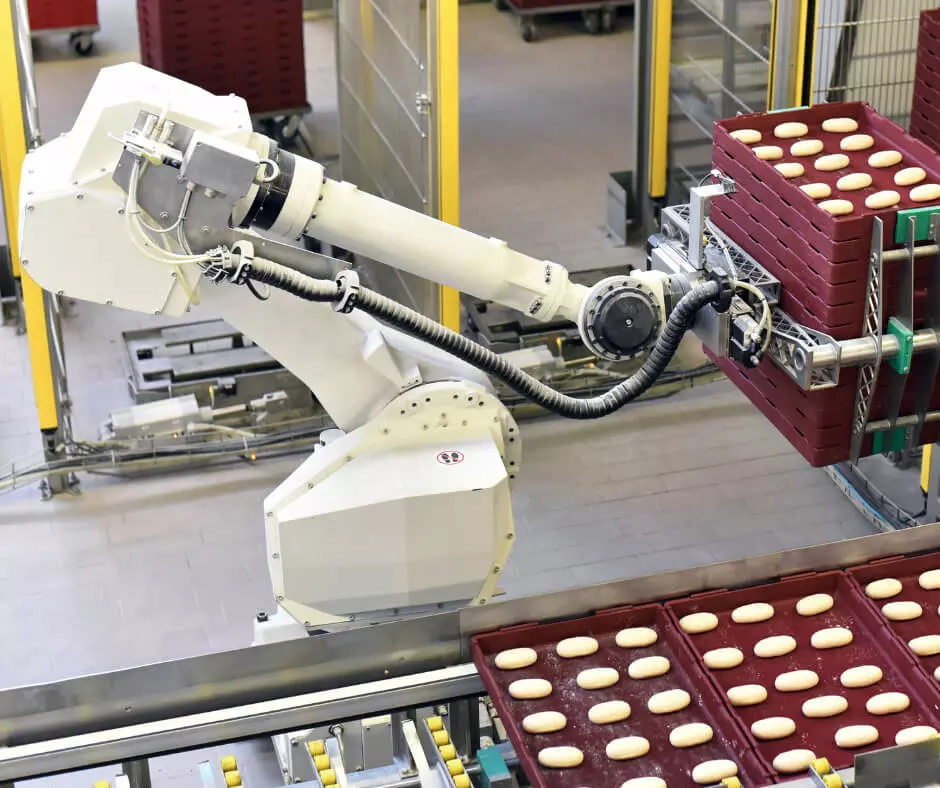
ROBOTIC CELLS FOR THE FOOD INDUSTRY
Industrial robotics, born with the automotive production, found a big and positive expansion in the food industry. Food industry means both food and beverages production and today in Italy is in first place for global turnover in the manufacturing sector.
The industrial production process in the food field is very driven towards the respect of qualitative and hygienic standards. In Italy the search for the organoleptic quality of the food product, the care and respect for raw materials are linked to a protection of the territory, traditions, and gastronomic culture. Even in the case of an automated production process, be it industrial or artisanal.
It is a working philosophy, a way of thinking, which is what allows our Italian food products to be appreciated worldwide. For such a growing sector, however, speed is everything.
Automation response
Rapidity and flexibility are two inherent characteristics of industrial robotic automation and two necessities of the food industries that wish to remain competitive in a market where demand is extremely high and the desire for change is always just around the corner.
Entrusting some phases of production or logistics to industrial robots is a suitable choice for most Italian companies. In fact, a robotic cell is applicable in many different business contexts. You can have just one, or you can create a fully automated production line.
In any case, it is not only the company's productivity that will benefit, but also the operators, who can be helped in heavy or dangerous tasks. Let's think about the storage of goods, the palletization of packages or pallets, the withdrawal of products at the end of the production line. The robotic applications in the food & beverage field are many, not least the packaging of goods themselves.
The goal of increasing production and ensuring impeccable quality standards can be achieved thanks to the extreme flexibility of robotic cells. In the food industry they can deal with:
- Filling of containers and packages
- Picking, moving and palletizing of packages
- Packaging
- Conformity control and rejection of unsuitable packages
- Handling and selection of raw materials
Industrial robots, obviously, can also be designed to take care of more delicate stages of food processing, such as cutting, slicing, punching food, and other handling steps that can be automated to suit the production line.
In this industrial sector, automations can be designed to be applied at any point of the production line, calibrating them according to the most useful task, from pick&place to palletizing.
Industrial robotics dedicated to food
Robotic cells designed for the food industry are made with specific electronically nickel-plated coatings. It is important, in fact, to avoid any risk of chipping or falling of foreign bodies that could contaminate food or beverages.
Industrial robots that are used in this field, also, are not equipped with springs or adhesives and comply with IP69K standards, which is. the maximum degree of protection from solid bodies and liquids, even at high pressure and high temperature. In this way, they can be adequately cleaned, an essential detail in a food production line where hygiene and safety are essential requirements.
The operator does not, however, disappear from the process where industrial robotic solutions are applied, but stays as a supervisor: he is responsible for checking that the robotic cell is operating correctly and for intervening if the need arises. In the meantime, he can dedicate himself to more qualified activities.
The most used robots in robotic cells for the food industry are mainly anthropomorphic robots, but other types of robots on the market are also widely used, such as Delta, SCARA and cartesian robots.
A peculiar role is played by Cobots, - easily integrated within a cell- whose plus is that they are safer for human operators. They are perfect for processes where the risk coefficient is very high and where an intelligent and cutting-edge simplification of the production process is required.
In general, robotic cells usually have small footprints, which makes them an ideal solution even for PMIs that do not have large spaces available.
The advantages of robotic cells for the food industry
Tera Automation has also designed two models of robotic cells suitable for the food context:
- T-Flexicell for the manipulation of food and beverage
- T-Flexipack for palletizing/depalletizing to be placed at the end of the line
The main advantages that a robotic cell of this kind can bring is this fiels are:
- 24/34 working
- No need for supervised work
- Reliability and quality repeatability
- Design flexibility
- Adaptability to various formats
- Decrease in production costs
- Robots much faster than humans: increased productivity
- Rapid return on investment
Let’s not forget about the fact that these types of automation can be equipped with a system for storing and managing production data, which can be displayed in the form of analytical charts and filtered by product format, unit of measure, date, etc. This web app, JARVIS, designed by Tera Automation, allows you to get a clear overview of production trends over time and is very easy to use.
